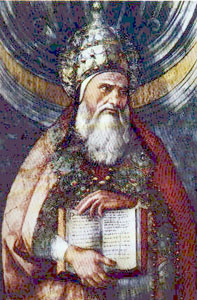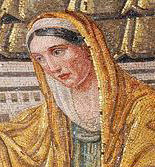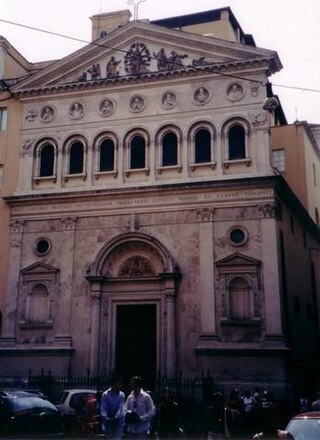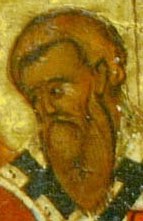
Pius I was the bishop of Rome from c. 140 to his death c. 154, according to the Annuario Pontificio. His dates are listed as 142 or 146 to 157 or 161, respectively. He is considered to have opposed both the Valentinians and Gnostics during his papacy. He is considered a saint by the Catholic Church and the Eastern Orthodox Church with a feast day in 11 July, but it is unclear if he died as a martyr.

Saints Faith, Hope, and Charity, are a group of Christian martyred saints who are venerated together with their mother, Sophia ("Wisdom").

Pudentiana is a virgin and martyr of the 2nd century who refused to worship the Roman Emperors Marcus Aurelius and Antoninus Pius as deities. She is sometimes locally known as "Potentiana" and is often coupled with her sister, Praxedes the martyr.

Prisca was a young Roman woman allegedly tortured and executed for her Christian faith. The dates of her birth and death are unknown. She is revered as a saint and martyr in Eastern Orthodoxy, by the Catholic Church, and in the Anglican Communion.

Santa Pudenziana is a church of Rome, a basilica built in the 4th century and dedicated to Saint Pudentiana, sister of Praxedes and daughter of Pudens. It is one of the national churches in Rome, associated with Filipinos.

Saints Simplicius, Faustinus and Beatrix were siblings martyred in Rome during the Diocletian persecution.
Saints Marius, Martha, Audifax, and Abachum were, according to their largely legendary passio of the 6th century, four saints of the same family. They came from Persia to Rome, and were martyred in 270 for sympathizing with Christian martyrs and burying their bodies. Some ancient martyrologies place the date of their death between 268 and 270, during the reign of Claudius II, although there was no persecution of Christians during this time.
Quintus Cornelius Pudens was a Roman senator and early Christian.

Saint Novatus is an early Christian saint. His feast day is 20 June.

Jovita and Faustinus were said to be Christian martyrs under Hadrian. Their traditional date of death is 120. They are patron saints of Brescia. Faustinus is the patron saint of Pietradefusi.

Martinian and Processus were Christian martyrs of ancient Rome. Neither the years they lived nor the circumstances of their deaths are known. They are currently buried in St. Peter's Basilica in Rome.

Susanna of Rome was a Christian martyr of the Diocletianic Persecution. Her existing hagiography, written between about 450 and 500 AD, is of no historical value and the relations it attributes to Susanna are entirely fictitious. It is probable that a real martyr named Susanna lies behind the literary invention.

Saints Cyprian and Justina are honored in the Catholic Church, Eastern Orthodox Church and Oriental Orthodoxy as Christians of Antioch, who in 304, during the Diocletianic Persecution, suffered martyrdom at Nicomedia on September 26. According to Roman Catholic sources, no Bishop of Antioch bore the name of Cyprian.

Saint Praxedes, called "a Roman maiden", was a saint and virgin who lived in the Roman Empire during the 2nd century. Along with her sister, Saint Pudentiana, she provided for the poor and gave care and comfort to persecuted Christians and martyrs. Her veneration began in the 4th century and many churches have been dedicated to her.

Symphorian, Timotheus (Timothy), and Hippolytus of Rome are three Christian martyrs who, though they were unrelated and were killed in different places and at different times, shared a common feast day in the General Roman Calendar from at least the 1568 Tridentine calendar to the Mysterii Paschalis. While still a young man, Symphorian was either beheaded or beaten to death with clubs.

David Lewis, S.J. was a Jesuit Catholic priest and martyr who was also known as Charles Baker. Lewis was canonized by Pope Paul VI in 1970 as one of the Forty Martyrs of England and Wales and is venerated as a saint in the Catholic Church. His feast day is celebrated on 27 August.

Petronilla is an early Christian saint. She is venerated as a virgin by the Catholic Church. She died in Rome at the end of the 1st century, or possibly in the 3rd century.
Saint Quirinus of Tivoli is venerated as a martyr and saint of the Catholic Church. His cult is centered at Tivoli. Quirinus of Tivoli may be the same saint as Quirinus of Sescia, whose relics were carried from Pannonia to Rome, and perhaps Tivoli as well, explaining the existence of a cult to Saint Quirinus of Tivoli. According to this interpretation Quirinus of Sescia relics were reportedly moved to Apennine Peninsula during the invasion of the Huns.

The Pontifical French Seminary is a Roman College dedicated to training French-speaking Roman Catholic priests.

Christina of Bolsena, also known as Christine of Bolsena, or in the Eastern Orthodox Church as Christina the Great martyr, is venerated as a virgin martyr of the third century. Archaeological excavations of an underground cemetery constructed over her tomb have shown that she was venerated at Bolsena by the fourth century.

















